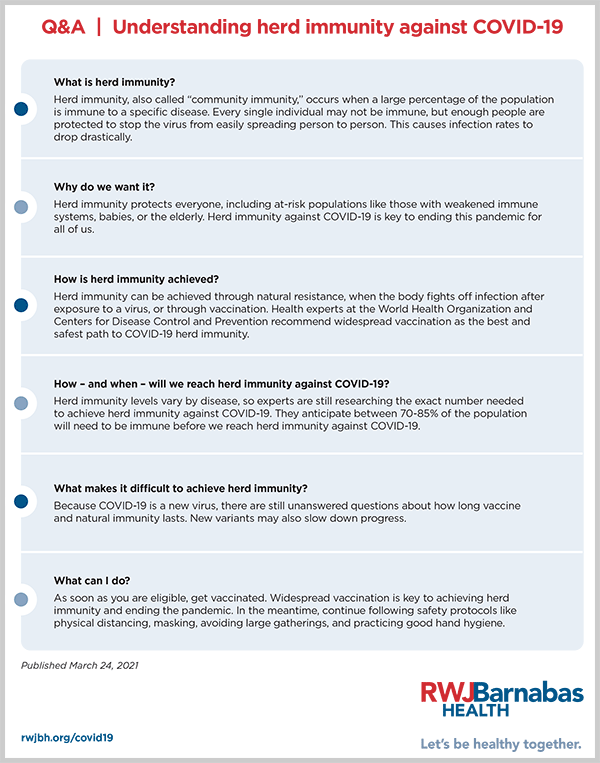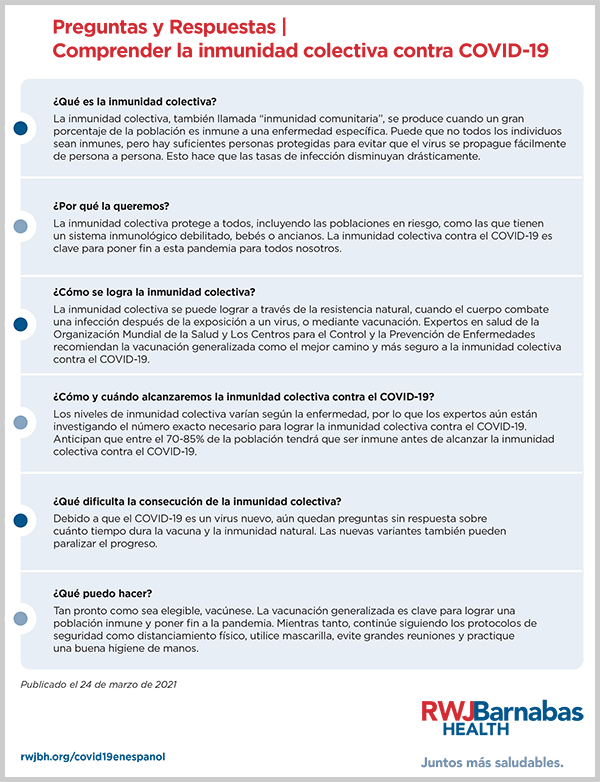What is herd immunity?
Herd immunity, also called “community immunity,” occurs when a large percentage of the population is immune to a specific disease. Every single individual may not be immune, but enough people are protected to stop the virus from easily spreading person to person. This causes infection rates to drop drastically.
Why do we want it?
Herd immunity protects everyone, including at-risk populations like those with weakened immune systems, babies, or the elderly. Herd immunity against COVID-19 is key to ending this pandemic for all of us.
How is herd immunity achieved?
Herd immunity can be achieved through natural resistance, when the body fights off infection after exposure to a virus, or through vaccination. Health experts at the World Health Organization and Centers for Disease Control and Prevention recommend widespread vaccination as the best and safest path to COVID-19 herd immunity.
How – and when – will we reach herd immunity against COVID-19?
Herd immunity levels vary by disease, so experts are still researching the exact number needed to achieve herd immunity against COVID-19. They anticipate between 70-85% of the population will need to be immune before we reach herd immunity against COVID-19.
What makes it difficult to achieve herd immunity?
Because COVID-19 is a new virus, there are still unanswered questions about how long vaccine and natural immunity lasts. New variants may also slow down progress.
What can I do?
As soon as you are eligible, get vaccinated. Widespread vaccination is key to achieving herd immunity and ending the pandemic. In the meantime, continue following safety protocols like physical distancing, masking, avoiding large gatherings, and practicing good hand hygiene.
COVID-19 vaccines are now available for ages 12 and up.
For more COVID-19 resources visit: rwjbh.org/covid19.
Preguntas y Respuestas | Comprender la inmunidad colectiva contra COVID-19
¿Qué es la inmunidad colectiva?
La inmunidad colectiva, también llamada “inmunidad comunitaria”, se produce cuando un gran porcentaje de la población es inmune a una enfermedad específica. Puede que no todos los individuos sean inmunes, pero hay suficientes personas protegidas para evitar que el virus se propague fácilmente de persona a persona. Esto hace que las tasas de infección disminuyan drásticamente.
¿Por qué la queremos?
La inmunidad colectiva protege a todos, incluyendo las poblaciones en riesgo, como las que tienen un sistema inmunológico debilitado, bebés o ancianos. La inmunidad colectiva contra el COVID-19 es clave para poner fin a esta pandemia para todos nosotros.
¿Cómo se logra la inmunidad colectiva?
La inmunidad colectiva se puede lograr a través de la resistencia natural, cuando el cuerpo combate una infección después de la exposición a un virus, o mediante vacunación. Expertos en salud de la Organización Mundial de la Salud y Los Centros para el Control y la Prevención de Enfermedades recomiendan la vacunación generalizada como el mejor camino y más seguro a la inmunidad colectiva contra el COVID-19.
¿Cómo y cuándo alcanzaremos la inmunidad colectiva contra el COVID-19?
Los niveles de inmunidad colectiva varían según la enfermedad, por lo que los expertos aún están investigando el número exacto necesario para lograr la inmunidad colectiva contra el COVID-19. Anticipan que entre el 70-85% de la población tendrá que ser inmune antes de alcanzar la inmunidad colectiva contra el COVID-19.
¿Qué dificulta la consecución de la inmunidad colectiva?
Debido a que el COVID-19 es un virus nuevo, aún quedan preguntas sin respuesta sobre cuánto tiempo dura la vacuna y la inmunidad natural. Las nuevas variantes también pueden paralizar el progreso.
Las vacunas contra el COVID-19 ya están disponibles para mayores de 12 años.
Para obtener más información sobre COVID-19, visite rwjbh.org/covid19enespanol.

